1.2: Mandhari na Dhana za Biolojia
- Page ID
- 175390
Ujuzi wa Kuendeleza
- Kutambua na kuelezea mali ya maisha
- Eleza viwango vya shirika kati ya vitu vilivyo hai
- Kutambua na kutafsiri mti wa phylogenetic
- Orodha ya mifano ya taaluma ndogo tofauti katika biolojia
Biolojia ni sayansi inayochunguza maisha, lakini ni nini hasa maisha? Hii inaweza kuonekana kama swali la silly na majibu ya wazi, lakini si rahisi kila wakati kufafanua maisha. Kwa mfano, tawi la biolojia linaloitwa virology linasoma virusi, ambalo linaonyesha baadhi ya sifa za vyombo hai lakini hukosa wengine. Inageuka kuwa ingawa virusi vinaweza kushambulia viumbe hai, kusababisha magonjwa, na hata kuzaliana, hazifikiri vigezo ambavyo wanabiolojia hutumia kufafanua maisha. Kwa hiyo, virologists si biologists, madhubuti kusema. Vilevile, baadhi ya wanabiolojia wanasoma mageuzi ya awali ya Masi yaliyotoa kupanda kwa uhai; kwa kuwa matukio yaliyotangulia maisha si matukio ya kibiolojia, wanasayansi hawa pia wametengwa na biolojia kwa maana kali ya neno hilo.
Kutoka mwanzo wake wa mwanzo, biolojia ina wrestled na maswali matatu: Ni mali ya pamoja kwamba kufanya kitu “hai” nini? Na mara tu tunajua kitu kilicho hai, tunawezaje kupata viwango vya maana vya shirika katika muundo wake? Na, hatimaye, wakati wanakabiliwa na tofauti ya ajabu ya maisha, tunawezaje kuandaa aina mbalimbali za viumbe ili tuweze kuzielewa vizuri? Kama viumbe vipya vinavyogunduliwa kila siku, wanabiolojia wanaendelea kutafuta majibu ya maswali haya na mengine.
Mali ya Maisha
Viumbe hai vyote hushiriki sifa kadhaa muhimu au kazi: utaratibu, unyeti au kukabiliana na mazingira, uzazi, kukabiliana na hali, ukuaji na maendeleo, udhibiti, homeostasis, usindikaji wa nishati, na mageuzi. Inapotazamwa pamoja, sifa hizi tisa hutumikia kufafanua maisha.
Order
Viumbe vinapangwa sana, miundo iliyoratibiwa ambayo inajumuisha seli moja au zaidi. Hata rahisi sana, viumbe vya seli moja ni ngumu sana: ndani ya kila seli, atomi hufanya molekuli; hizi pia hufanya organelles za seli na inclusions nyingine za mkononi. Katika viumbe vingi (Kielelezo\(\PageIndex{1}\)), seli zinazofanana huunda tishu. Tishu, kwa upande wake, hushirikiana kuunda viungo (miundo ya mwili yenye kazi tofauti). Viungo vinafanya kazi pamoja ili kuunda mifumo ya chombo.
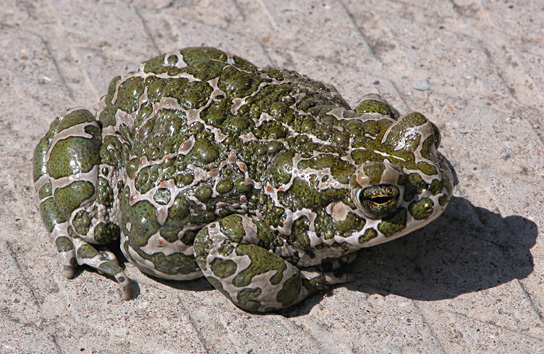
Sensitivity au Response kwa
Viumbe hujibu kwa msukumo tofauti. Kwa mfano, mimea inaweza kuinama kuelekea chanzo cha mwanga, kupanda juu ya ua na kuta, au kujibu kugusa (Kielelezo\(\PageIndex{2}\)). Hata bakteria vidogo vinaweza kusonga kuelekea au mbali na kemikali (mchakato unaoitwa chemotaxis) au mwanga (phototaxis). Movement kuelekea kichocheo inachukuliwa kuwa majibu mazuri, wakati harakati mbali na kichocheo inachukuliwa kuwa jibu hasi.
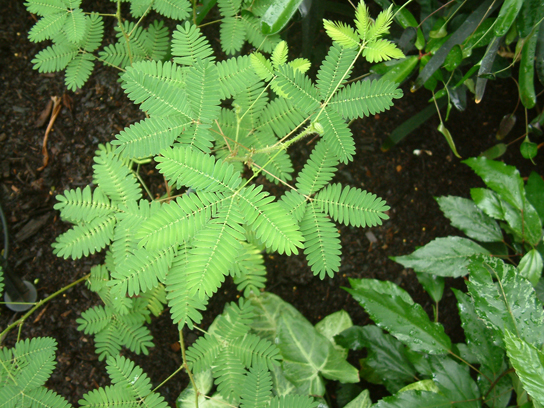
Unganisha na Kujifunza
Video: Tazama video hii ili uone jinsi mimea inavyoitikia kichocheo - kuanzia kufunguliwa kwa mwanga, hadi kuifunga tendril kuzunguka tawi, na kukamata mawindo.
Uzazi
Viumbe vya seli moja huzaa kwa mara ya kwanza kurudia DNA yao, halafu kuigawanya sawasawa kadiri seli huandaa kugawa ili kuunda seli mbili mpya. Viumbe vingi vya seli mara nyingi huzalisha seli maalumu za uzazi za uzazi ambazo zitaunda watu wapya. Wakati uzazi hutokea, jeni zenye DNA hupitishwa pamoja na watoto wa kiumbe. Jeni hizi zinahakikisha kwamba watoto watakuwa wa aina moja na watakuwa na sifa zinazofanana, kama ukubwa na umbo.
Ukuaji na Maendeleo
Viumbe hukua na kuendeleza kufuatia maagizo maalum yanayosimbwa kwa jeni zao. Jeni hizi hutoa maelekezo ambayo yataongoza ukuaji wa seli na maendeleo, kuhakikisha kwamba vijana wa aina (Kielelezo\(\PageIndex{3}\)) itakua ili kuonyesha sifa nyingi sawa na wazazi wake.
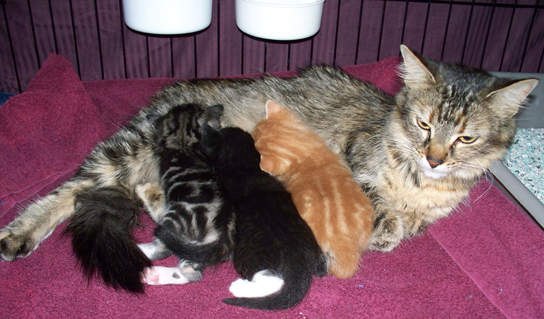
Taratibu
Hata viumbe vidogo ni ngumu na vinahitaji taratibu nyingi za udhibiti ili kuratibu kazi za ndani, kujibu msisitizo, na kukabiliana na matatizo ya mazingira. Mifano miwili ya kazi za ndani zilizowekwa katika viumbe ni usafiri wa virutubisho na mtiririko wa damu. Viungo (vikundi vya tishu vinavyofanya kazi pamoja) hufanya kazi maalum, kama vile kubeba oksijeni katika mwili wote, kuondoa taka, kutoa virutubisho kwa kila seli, na kuimarisha mwili.
Homeostasis
Ili kufanya kazi vizuri, seli zinahitaji kuwa na hali zinazofaa kama vile joto sahihi, pH, na mkusanyiko sahihi wa kemikali mbalimbali. Hali hizi zinaweza, hata hivyo, kubadilika kutoka wakati mmoja hadi ujao. Viumbe vinaweza kudumisha hali ya ndani ndani ya aina nyembamba karibu daima, licha ya mabadiliko ya mazingira, kupitia homeostasis (literally, “hali thabiti”) -uwezo wa kiumbe kudumisha hali ya ndani ya mara kwa mara. Kwa mfano, kiumbe kinahitaji kudhibiti joto la mwili kupitia mchakato unaojulikana kama thermoregulation. Viumbe vinavyoishi katika hali ya hewa ya baridi, kama vile kubeba polar (Kielelezo\(\PageIndex{4}\)), vina miundo ya mwili inayowasaidia kuhimili joto la chini na kuhifadhi joto la mwili. Miundo ambayo inasaidia katika aina hii ya insulation ni pamoja na manyoya, manyoya, blubber, na mafuta. Katika hali ya hewa ya joto, viumbe vina mbinu (kama vile jasho kwa binadamu au kupiga mbwa) zinazowasaidia kumwaga joto la mwili kupita kiasi.
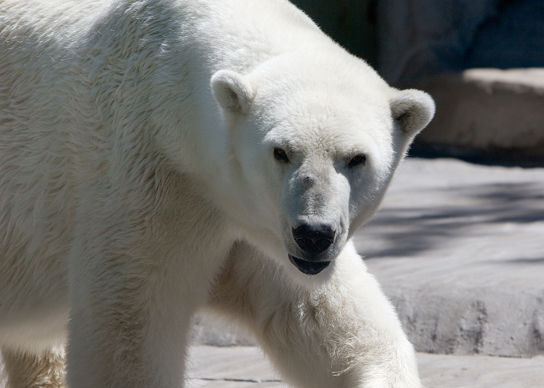
Nishati Usindikaji
Viumbe vyote hutumia chanzo cha nishati kwa shughuli zao za kimetaboliki. Baadhi ya viumbe hukamata nishati kutoka jua na kuibadilisha kuwa nishati ya kemikali katika chakula; wengine hutumia nishati ya kemikali katika molekuli wanazozichukua kama chakula (Kielelezo\(\PageIndex{5}\)).
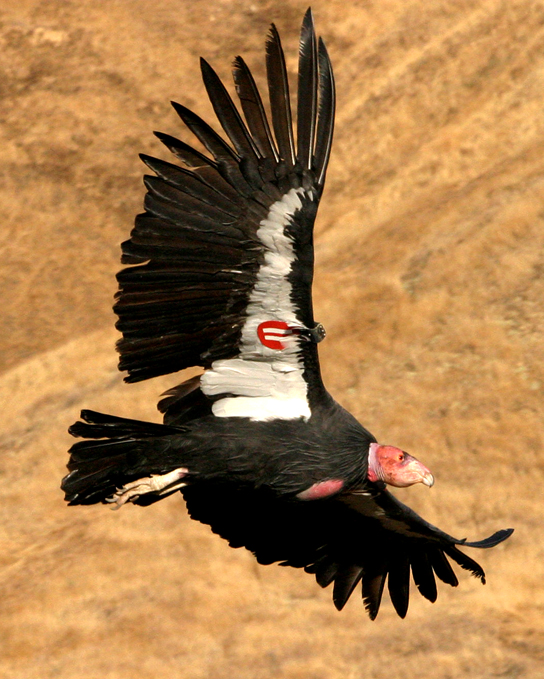
Ngazi za Shirika la Mambo ya Kuishi
Mambo yaliyo hai yanapangwa sana na muundo, kufuatia uongozi ambao unaweza kuchunguzwa kwa kiwango kutoka ndogo hadi kubwa. Atomu ni kitengo kidogo na cha msingi zaidi cha suala. Lina kiini kilichozungukwa na elektroni. Atomi huunda molekuli. Molekuli ni muundo wa kemikali yenye angalau atomi mbili zilizoshikiliwa pamoja na vifungo kimoja au zaidi vya kemikali. Molekuli nyingi ambazo ni muhimu kibiolojia ni macromolecules, molekuli kubwa ambazo kwa kawaida hutengenezwa na upolimishaji (polymer ni molekuli kubwa inayofanywa kwa kuchanganya vitengo vidogo vinavyoitwa monoma, ambazo ni rahisi kuliko macromolecules). Mfano wa macromolecule ni asidi deoxyribonucleic (DNA) (Kielelezo\(\PageIndex{6}\)), ambayo ina maelekezo ya muundo na utendaji wa viumbe vyote vilivyo hai.
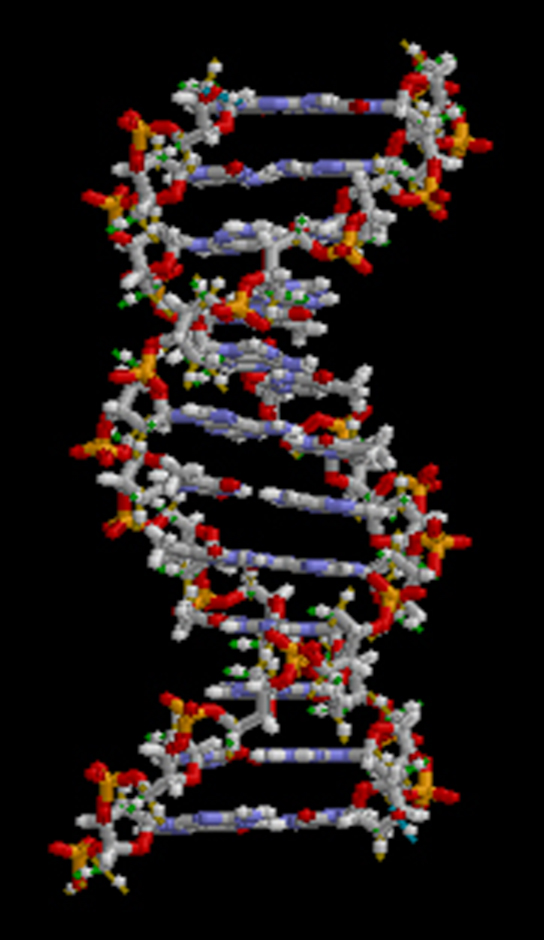
Unganisha na Kujifunza

Video: Watch video hii kwamba animates muundo tatu-dimensional ya molekuli DNA inavyoonekana katika Kielelezo\(\PageIndex{6}\).
Some cells contain aggregates of macromolecules surrounded by membranes; these are called organelles. Organelles are small structures that exist within cells. Examples of organelles include mitochondria and chloroplasts, which carry out indispensable functions: mitochondria produce energy to power the cell, while chloroplasts enable green plants to utilize the energy in sunlight to make sugars. All living things are made of cells; the cell itself is the smallest fundamental unit of structure and function in living organisms. (This requirement is why viruses are not considered living: they are not made of cells. To make new viruses, they have to invade and hijack the reproductive mechanism of a living cell; only then can they obtain the materials they need to reproduce.) Some organisms consist of a single cell and others are multicellular. Cells are classified as prokaryotic or eukaryotic. Prokaryotes are single-celled or colonial organisms that do not have membrane-bound nuclei; in contrast, the cells of eukaryotes do have membrane-bound organelles and a membrane-bound nucleus.
In larger organisms, cells combine to make tissues, which are groups of similar cells carrying out similar or related functions. Organs are collections of tissues grouped together performing a common function. Organs are present not only in animals but also in plants. An organ system is a higher level of organization that consists of functionally related organs. Mammals have many organ systems. For instance, the circulatory system transports blood through the body and to and from the lungs; it includes organs such as the heart and blood vessels. Organisms are individual living entities. For example, each tree in a forest is an organism. Single-celled prokaryotes and single-celled eukaryotes are also considered organisms and are typically referred to as microorganisms.
All the individuals of a species living within a specific area are collectively called a population. For example, a forest may include many pine trees. All of these pine trees represent the population of pine trees in this forest. Different populations may live in the same specific area. For example, the forest with the pine trees includes populations of flowering plants and also insects and microbial populations. A community is the sum of populations inhabiting a particular area. For instance, all of the trees, flowers, insects, and other populations in a forest form the forest’s community. The forest itself is an ecosystem. An ecosystem consists of all the living things in a particular area together with the abiotic, non-living parts of that environment such as nitrogen in the soil or rain water. At the highest level of organization (Figure \(\PageIndex{7}\)), the biosphere is the collection of all ecosystems, and it represents the zones of life on earth. It includes land, water, and even the atmosphere to a certain extent.
Art Connection
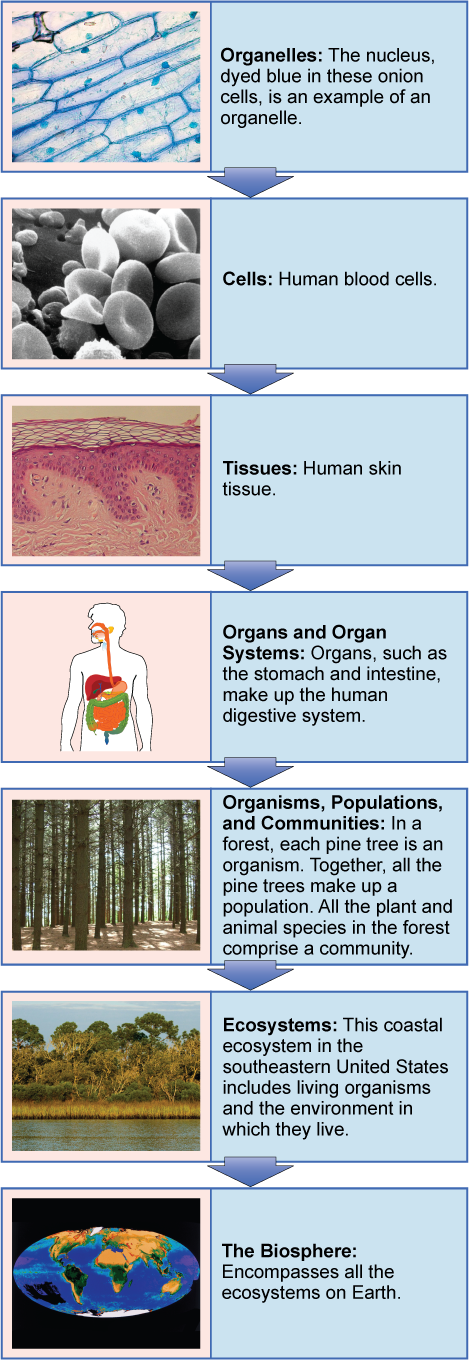
Which of the following statements is false?
- Tissues exist within organs which exist within organ systems.
- Communities exist within populations which exist within ecosystems.
- Organelles exist within cells which exist within tissues.
- Communities exist within ecosystems which exist in the biosphere.
The Diversity of Life
The fact that biology, as a science, has such a broad scope has to do with the tremendous diversity of life on earth. The source of this diversity is evolution, the process of gradual change during which new species arise from older species. Evolutionary biologists study the evolution of living things in everything from the microscopic world to ecosystems.
The evolution of various life forms on Earth can be summarized in a phylogenetic tree (Figure \(\PageIndex{8}\)). A phylogenetic tree is a diagram showing the evolutionary relationships among biological species based on similarities and differences in genetic or physical traits or both. A phylogenetic tree is composed of nodes and branches. The internal nodes represent ancestors and are points in evolution when, based on scientific evidence, an ancestor is thought to have diverged to form two new species. The length of each branch is proportional to the time elapsed since the split.
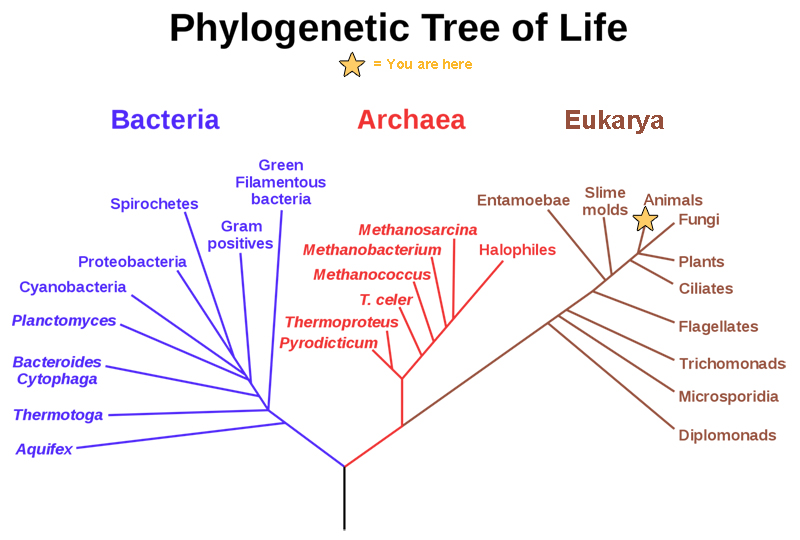
Evolution Connection: Carl Woese and the Phylogenetic Tree
In the past, biologists grouped living organisms into five kingdoms: animals, plants, fungi, protists, and bacteria. The organizational scheme was based mainly on physical features, as opposed to physiology, biochemistry, or molecular biology, all of which are used by modern systematics. The pioneering work of American microbiologist Carl Woese in the early 1970s has shown, however, that life on Earth has evolved along three lineages, now called domains—Bacteria, Archaea, and Eukarya. The first two are prokaryotic cells with microbes that lack membrane-enclosed nuclei and organelles. The third domain contains the eukaryotes and includes unicellular microorganisms together with the four original kingdoms (excluding bacteria). Woese defined Archaea as a new domain, and this resulted in a new taxonomic tree (Figure \(\PageIndex{8}\)). Many organisms belonging to the Archaea domain live under extreme conditions and are called extremophiles. To construct his tree, Woese used genetic relationships rather than similarities based on morphology (shape).
Woese’s tree was constructed from comparative sequencing of the genes that are universally distributed, present in every organism, and conserved (meaning that these genes have remained essentially unchanged throughout evolution). Woese’s approach was revolutionary because comparisons of physical features are insufficient to differentiate between the prokaryotes that appear fairly similar in spite of their tremendous biochemical diversity and genetic variability (Figure \(\PageIndex{9}\)). The comparison of homologous DNA and RNA sequences provided Woese with a sensitive device that revealed the extensive variability of prokaryotes, and which justified the separation of the prokaryotes into two domains: bacteria and archaea.
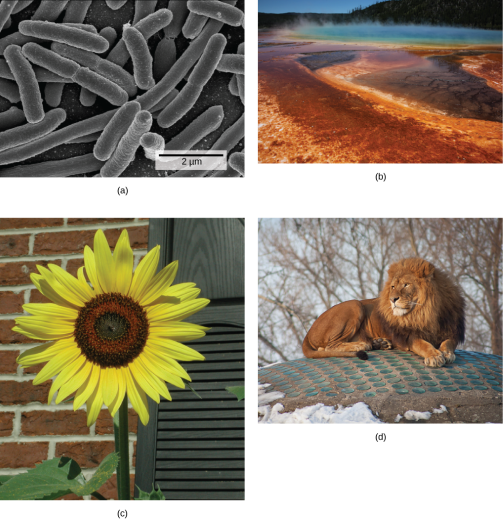
Branches of Biological Study
The scope of biology is broad and therefore contains many branches and subdisciplines. Biologists may pursue one of those subdisciplines and work in a more focused field. For instance, molecular biology and biochemistry study biological processes at the molecular and chemical level, including interactions among molecules such as DNA, RNA, and proteins, as well as the way they are regulated. Microbiology, the study of microorganisms, is the study of the structure and function of single-celled organisms. It is quite a broad branch itself, and depending on the subject of study, there are also microbial physiologists, ecologists, and geneticists, among others.
Career Connection: Forensic Scientist
Forensic science is the application of science to answer questions related to the law. Biologists as well as chemists and biochemists can be forensic scientists. Forensic scientists provide scientific evidence for use in courts, and their job involves examining trace materials associated with crimes. Interest in forensic science has increased in the last few years, possibly because of popular television shows that feature forensic scientists on the job. Also, the development of molecular techniques and the establishment of DNA databases have expanded the types of work that forensic scientists can do. Their job activities are primarily related to crimes against people such as murder, rape, and assault. Their work involves analyzing samples such as hair, blood, and other body fluids and also processing DNA (Figure \(\PageIndex{10}\)) found in many different environments and materials. Forensic scientists also analyze other biological evidence left at crime scenes, such as insect larvae or pollen grains. Students who want to pursue careers in forensic science will most likely be required to take chemistry and biology courses as well as some intensive math courses.
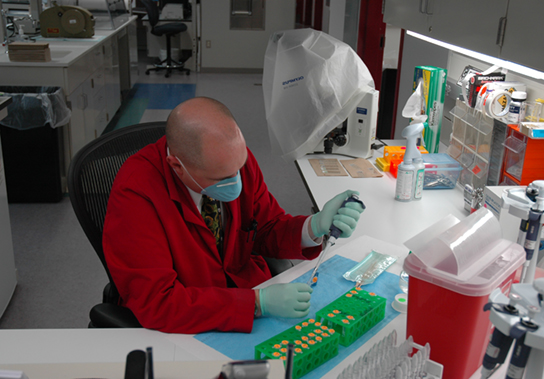
Another field of biological study, neurobiology, studies the biology of the nervous system, and although it is considered a branch of biology, it is also recognized as an interdisciplinary field of study known as neuroscience. Because of its interdisciplinary nature, this subdiscipline studies different functions of the nervous system using molecular, cellular, developmental, medical, and computational approaches.
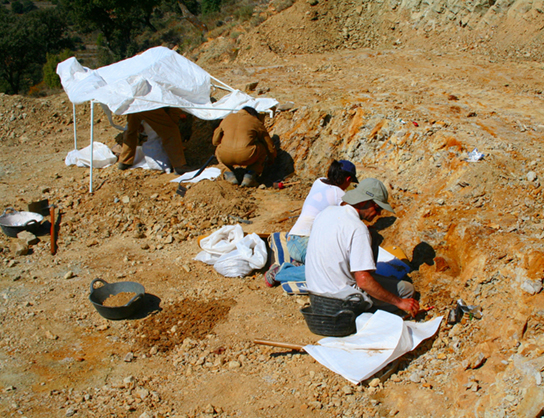
Paleontology, another branch of biology, uses fossils to study life’s history (Figure \(\PageIndex{11}\)). Zoology and botany are the study of animals and plants, respectively. Biologists can also specialize as biotechnologists, ecologists, or physiologists, to name just a few areas. This is just a small sample of the many fields that biologists can pursue.
Biology is the culmination of the achievements of the natural sciences from their inception to today. Excitingly, it is the cradle of emerging sciences, such as the biology of brain activity, genetic engineering of custom organisms, and the biology of evolution that uses the laboratory tools of molecular biology to retrace the earliest stages of life on earth. A scan of news headlines—whether reporting on immunizations, a newly discovered species, sports doping, or a genetically-modified food—demonstrates the way biology is active in and important to our everyday world.
Summary
Biology is the science of life. All living organisms share several key properties such as order, sensitivity or response to stimuli, reproduction, growth and development, regulation, homeostasis, and energy processing. Living things are highly organized parts of a hierarchy that includes atoms, molecules, organelles, cells, tissues, organs, and organ systems. Organisms, in turn, are grouped as populations, communities, ecosystems, and the biosphere. The great diversity of life today evolved from less-diverse ancestral organisms over billions of years. A diagram called a phylogenetic tree can be used to show evolutionary relationships among organisms.
Biology is very broad and includes many branches and subdisciplines. Examples include molecular biology, microbiology, neurobiology, zoology, and botany, among others.
Art Connections
Figure \(\PageIndex{7}\): Which of the following statements is false?
- Tissues exist within organs which exist within organ systems.
- Communities exist within populations which exist within ecosystems.
- Organelles exist within cells which exist within tissues.
- Communities exist within ecosystems which exist in the biosphere.
- Answer
-
Communities exist within populations which exist within ecosystems.
Glossary
- atom
- smallest and most fundamental unit of matter
- biochemistry
- study of the chemistry of biological organisms
- biosphere
- collection of all the ecosystems on Earth
- botany
- study of plants
- cell
- smallest fundamental unit of structure and function in living things
- community
- set of populations inhabiting a particular area
- ecosystem
- all the living things in a particular area together with the abiotic, nonliving parts of that environment
- eukaryote
- organism with cells that have nuclei and membrane-bound organelles
- evolution
- process of gradual change during which new species arise from older species and some species become extinct
- homeostasis
- ability of an organism to maintain constant internal conditions
- macromolecule
- large molecule, typically formed by the joining of smaller molecules
- microbiology
- study of the structure and function of microorganisms
- molecule
- chemical structure consisting of at least two atoms held together by one or more chemical bonds
- molecular biology
- study of biological processes and their regulation at the molecular level, including interactions among molecules such as DNA, RNA, and proteins
- neurobiology
- study of the biology of the nervous system
- organ
- collection of related tissues grouped together performing a common function
- organ system
- level of organization that consists of functionally related interacting organs
- organelle
- small structures that exist within cells and carry out cellular functions
- organism
- individual living entity
- paleontology
- study of life’s history by means of fossils
- phylogenetic tree
- diagram showing the evolutionary relationships among various biological species based on similarities and differences in genetic or physical traits or both; in essence, a hypothesis concerning evolutionary connections
- population
- all of the individuals of a species living within a specific area
- prokaryote
- single-celled organism that lacks organelles and does not have nuclei surrounded by a nuclear membrane
- tissue
- group of similar cells carrying out related functions
- zoology
- study of animals


